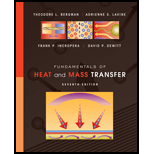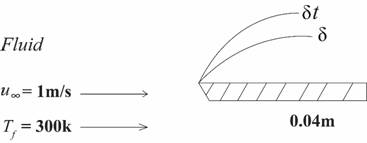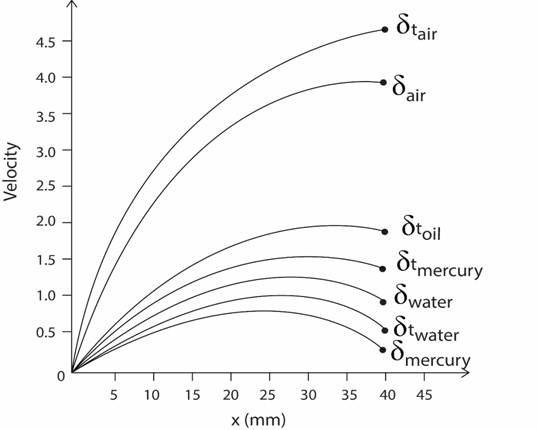
Consider the following fluids at a film temperature of 300 K in parallel flow over a flat plate with velocity of 1 m/s: atmospheric air, water, engine oil, and mercury.
- For each fluid, determine the velocity and thermal boundary layer thicknesses at a distance of 40 mm from the leading edge.
- For each of the prescribed fluids and on the same coordinates, plot the boundary layer thicknesses as a function of distance from the leading edge to a plate length of 40 mm.
(a)
The velocity and thermal boundary layer thickness at a distance of
Answer to Problem 7.1P
The thermal boundary layer thickness for air, water, oil and mercury is 4.48, 0.52, 1.27, and 1.17 respectively.
Explanation of Solution
Given Information:
Properties of air at
Properties of water at
Properties of engine oil at
Properties of mercury at
Concept used:
The equation of Reynolds number is
The formula for nusselt number is
The formula for average nusselt number is
The formula of laminar
Nusselt number:
It is the ratio of convective heat transfer to convective heat transfer across a boundary.
Where
Calculation:
Know that the equation of Reynolds number.
From the figure:

Put
Put
Know that the formula of laminar
Put
Convert the unit of laminar
Know that the formula of laminar
Put
Put
Know that the formula of laminar
Put
Know that the formula of laminar
Put
Put
Know that the formula of laminar
Put
Know that the formula of laminar
Put
Put
Know that the formula of laminar
Put
Know that the formula of laminar
Put
Conclusion:
Hence, the thermal boundary layer thickness for air, water, oil and mercury is 4.48, 0.52, 1.27, and 1.17 respectively.
b)
To draw: the boundary layer thickness from the leading edge to a plate length of
Answer to Problem 7.1P
Created the graph for determined values of thermal boundary layer thickness for air, water, oil and mercury is 4.48, 0.52, 1.27, and 1.17 respectively with the values oflaminar thermal boundary layer
Explanation of Solution
Given Information:
The thermal boundary layer thickness for air, water, oil and mercury is 4.48, 0.52, 1.27, and 1.17 respectively.
Entire length
Boundary layer
Concept used:
Plot the graph by Matlab software, obtained values by formulas correlation between Reynolds equation, Nusselt number, average nusselt number and boundary layer thickness.
Calculation:
Know that the determined values of thermal boundary layer thickness for air, water, oil, mercury are 4.48, 0.52, 1.27, and 1.17 respectively and determined values of the laminar thermal boundary layer are
Substitute the values of thermal boundary layer thickness and laminar thermal boundary on the graph.

Conclusion:
Created the graph for determined values of thermal boundary layer thickness for air, water, oil and mercury is 4.48, 0.52, 1.27, and 1.17 respectively with the values oflaminar thermal boundary layer
Want to see more full solutions like this?
Chapter 7 Solutions
Fundamentals of Heat and Mass Transfer
- PROBLEM 3.46 The solid cylindrical rod BC of length L = 600 mm is attached to the rigid lever AB of length a = 380 mm and to the support at C. When a 500 N force P is applied at A, design specifications require that the displacement of A not exceed 25 mm when a 500 N force P is applied at A For the material indicated determine the required diameter of the rod. Aluminium: Tall = 65 MPa, G = 27 GPa. Aarrow_forwardFind the equivalent mass of the rocker arm assembly with respect to the x coordinate. k₁ mi m2 k₁arrow_forward2. Figure below shows a U-tube manometer open at both ends and containing a column of liquid mercury of length l and specific weight y. Considering a small displacement x of the manometer meniscus from its equilibrium position (or datum), determine the equivalent spring constant associated with the restoring force. Datum Area, Aarrow_forward
- 1. The consequences of a head-on collision of two automobiles can be studied by considering the impact of the automobile on a barrier, as shown in figure below. Construct a mathematical model (i.e., draw the diagram) by considering the masses of the automobile body, engine, transmission, and suspension and the elasticity of the bumpers, radiator, sheet metal body, driveline, and engine mounts.arrow_forward3.) 15.40 – Collar B moves up at constant velocity vB = 1.5 m/s. Rod AB has length = 1.2 m. The incline is at angle = 25°. Compute an expression for the angular velocity of rod AB, ė and the velocity of end A of the rod (✓✓) as a function of v₂,1,0,0. Then compute numerical answers for ȧ & y_ with 0 = 50°.arrow_forward2.) 15.12 The assembly shown consists of the straight rod ABC which passes through and is welded to the grectangular plate DEFH. The assembly rotates about the axis AC with a constant angular velocity of 9 rad/s. Knowing that the motion when viewed from C is counterclockwise, determine the velocity and acceleration of corner F.arrow_forward
 Principles of Heat Transfer (Activate Learning wi...Mechanical EngineeringISBN:9781305387102Author:Kreith, Frank; Manglik, Raj M.Publisher:Cengage Learning
Principles of Heat Transfer (Activate Learning wi...Mechanical EngineeringISBN:9781305387102Author:Kreith, Frank; Manglik, Raj M.Publisher:Cengage Learning
